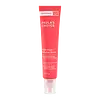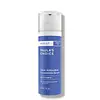What's inside
What's inside
 Key Ingredients
Key Ingredients

 Benefits
Benefits

 Concerns
Concerns

No concerns
 Ingredients Side-by-side
Ingredients Side-by-side

Water
Skin ConditioningGlycerin
HumectantButylene Glycol
HumectantCoco-Caprylate/Caprate
EmollientDecyl Oleate
EmollientCucumis Sativus Extract
Skin ConditioningArctostaphylos Uva-Ursi Leaf Extract
Skin ConditioningPropanediol
SolventGlutathione
Chondrus Crispus Extract
Skin ConditioningTetrahexyldecyl Ascorbate
AntioxidantVitis Vinifera Seed Extract
AntimicrobialUbiquinone
AntioxidantCurcumin
AntioxidantSilybum Marianum Fruit Extract
Skin ConditioningEpigallocatechin Gallate
AntioxidantAscophyllum Nodosum Extract
Skin ConditioningMoringa Oleifera Seed Oil
EmollientFucus Vesiculosus Extract
EmollientFicus Carica Fruit Extract
HumectantLeontopodium Alpinum Flower Extract
Skin ConditioningEmblica Officinalis Fruit Extract
Skin ConditioningButyrospermum Parkii Butter
Skin ConditioningLinoleic Acid
CleansingLinolenic Acid
CleansingPhytosphingosine Phosphate
Skin ConditioningThermus Thermophillus Ferment
Skin ConditioningTocopherol
AntioxidantSesamum Indicum Seed Oil
EmollientTocopheryl Acetate
AntioxidantLecithin
EmollientXanthan Gum
EmulsifyingAcacia Senegal Gum
MaskingEctoin
Skin ConditioningGlyceryl Stearate
EmollientPolyacrylamide
Cetearyl Alcohol
EmollientCaprylyl Glycol
EmollientC13-14 Isoparaffin
EmollientC12-15 Alkyl Benzoate
AntimicrobialPolysorbate 80
Emulsifying1,2-Hexanediol
Skin ConditioningLaureth-7
EmulsifyingDipropylene Glycol
HumectantPhenoxyethanol
PreservativeEthylhexylglycerin
Skin ConditioningWater, Glycerin, Butylene Glycol, Coco-Caprylate/Caprate, Decyl Oleate, Cucumis Sativus Extract, Arctostaphylos Uva-Ursi Leaf Extract, Propanediol, Glutathione, Chondrus Crispus Extract, Tetrahexyldecyl Ascorbate, Vitis Vinifera Seed Extract, Ubiquinone, Curcumin, Silybum Marianum Fruit Extract, Epigallocatechin Gallate, Ascophyllum Nodosum Extract, Moringa Oleifera Seed Oil, Fucus Vesiculosus Extract, Ficus Carica Fruit Extract, Leontopodium Alpinum Flower Extract, Emblica Officinalis Fruit Extract, Butyrospermum Parkii Butter, Linoleic Acid, Linolenic Acid, Phytosphingosine Phosphate, Thermus Thermophillus Ferment, Tocopherol, Sesamum Indicum Seed Oil, Tocopheryl Acetate, Lecithin, Xanthan Gum, Acacia Senegal Gum, Ectoin, Glyceryl Stearate, Polyacrylamide, Cetearyl Alcohol, Caprylyl Glycol, C13-14 Isoparaffin, C12-15 Alkyl Benzoate, Polysorbate 80, 1,2-Hexanediol, Laureth-7, Dipropylene Glycol, Phenoxyethanol, Ethylhexylglycerin
Cyclopentasiloxane
EmollientDimethicone
EmollientTetrahexyldecyl Ascorbate
AntioxidantPalmitoyl Tripeptide-5
Skin ConditioningCeramide NP
Skin ConditioningTocotrienols
Skin ConditioningTocopherol
AntioxidantUbiquinone
AntioxidantThioctic Acid
AntioxidantTocopheryl Acetate
AntioxidantMagnesium Ascorbyl Phosphate
AntioxidantFerulic Acid
AntimicrobialBeta-Glucan
Skin ConditioningSuperoxide Dismutase
AntioxidantEpigallocatechin Gallate
AntioxidantErgothioneine
AntioxidantGlutathione
Xanthophylls
Skin ConditioningGlycine Soja Seed Extract
Skin ConditioningGlycerin
HumectantArctostaphylos Uva Ursi Leaf Extract
Skin ConditioningLupinus Albus Seed Extract
Skin ConditioningCurcuma Longa Root
Skin ConditioningElaeis Guineensis Oil
EmollientPhenoxyethanol
PreservativeCyclopentasiloxane, Dimethicone, Tetrahexyldecyl Ascorbate, Palmitoyl Tripeptide-5, Ceramide NP, Tocotrienols, Tocopherol, Ubiquinone, Thioctic Acid, Tocopheryl Acetate, Magnesium Ascorbyl Phosphate, Ferulic Acid, Beta-Glucan, Superoxide Dismutase, Epigallocatechin Gallate, Ergothioneine, Glutathione, Xanthophylls, Glycine Soja Seed Extract, Glycerin, Arctostaphylos Uva Ursi Leaf Extract, Lupinus Albus Seed Extract, Curcuma Longa Root, Elaeis Guineensis Oil, Phenoxyethanol
 Reviews
Reviews

Ingredients Explained
These ingredients are found in both products.
Ingredients higher up in an ingredient list are typically present in a larger amount.
EGCG is most famous for being found in green tea. It is a type of catechin, a potent antioxidant. This ingredient has antioxidant and anti-inflammatory properties.
Antioxidants protect our skin from oxidative damage, helping with slowing the signs of aging.
A study from 2018 found EGCG to help reduce melanin and melanoma cells.
Learn more about the skin benefits of green tea here.
Learn more about Epigallocatechin GallateGlutathione is an antioxidant naturally found in our bodies. It is made up of three amino acids: glycine, cysteine, and glutamic acid.
As an antioxidant, it prevents oxidative damage to parts of our cell.
While glutathione is said to help with fading dark spots, the results from research are inconclusive. Further studies are needed. With that said, gluthatione has been shown to protect our skin from UV-B induced damage.
This ingredient is naturally occurring in plants, animals, fungi, and some bacteria.
Learn more about GlutathioneGlycerin is already naturally found in your skin. It helps moisturize and protect your skin.
A study from 2016 found glycerin to be more effective as a humectant than AHAs and hyaluronic acid.
As a humectant, it helps the skin stay hydrated by pulling moisture to your skin. The low molecular weight of glycerin allows it to pull moisture into the deeper layers of your skin.
Hydrated skin improves your skin barrier; Your skin barrier helps protect against irritants and bacteria.
Glycerin has also been found to have antimicrobial and antiviral properties. Due to these properties, glycerin is often used in wound and burn treatments.
In cosmetics, glycerin is usually derived from plants such as soybean or palm. However, it can also be sourced from animals, such as tallow or animal fat.
This ingredient is organic, colorless, odorless, and non-toxic.
Glycerin is the name for this ingredient in American English. British English uses Glycerol/Glycerine.
Learn more about GlycerinPhenoxyethanol is a preservative that has germicide, antimicrobial, and aromatic properties. Studies show that phenoxyethanol can prevent microbial growth. By itself, it has a scent that is similar to that of a rose.
It's often used in formulations along with Caprylyl Glycol to preserve the shelf life of products.
Tetrahexyldecyl Ascorbate (THD) is a stable and oil-soluble form of Vitamin C.
THD is special in that it has the ability to travel deeper into skin than traditional ascorbic acid while maintaining the same skin benefits (double win!).
Because it’s oil-soluble, THD dives deep into your skin’s fatty layers (think ceramides and cholesterol) to fight off the kind of free radicals that mess with your skin barrier. This makes it a great pair with water-based vitamin C (ascorbic acid) that mainly works on the surface.
Even at just 0.1%, THD is already showing great antioxidant activity. When used up to 2%, it helps keep your skin happy and calm, especially when it’s stressed from pollution or sun.
Want to fade dark spots or tackle hyperpigmentation? You’ll want 5% or more. Pairing it with brightening buddies like niacinamide or licorice root gives even better results. One study even used 30% THD with other brighteners and saw real results on stubborn discoloration, even in melasma-prone skin.
A note on THD: It’s has a slightly silky, oily texture and usually shows up colorless or pale yellow (though the exact shade can vary by supplier).
While you can sneak it into water-based formulas, it really shines when paired with silicones or oils, which help your skin soak it up better.
THD is pretty stable, but it’s still vulnerable to degradation like ascorbic acid. Too much light or heat (above 113°F / 45°C) can break it down over time. Go for dark and opaque packaging that keeps it safe and shady!
Read more about other types of Vitamin C:
Learn more about Tetrahexyldecyl AscorbateTocopherol (also known as Vitamin E) is a common antioxidant used to help protect the skin from free-radicals and strengthen the skin barrier. It's also fat soluble - this means our skin is great at absorbing it.
Vitamin E also helps keep your natural skin lipids healthy. Your lipid skin barrier naturally consists of lipids, ceramides, and fatty acids. Vitamin E offers extra protection for your skin’s lipid barrier, keeping your skin healthy and nourished.
Another benefit is a bit of UV protection. Vitamin E helps reduce the damage caused by UVB rays. (It should not replace your sunscreen). Combining it with Vitamin C can decrease sunburned cells and hyperpigmentation after UV exposure.
You might have noticed Vitamin E + C often paired together. This is because it is great at stabilizing Vitamin C. Using the two together helps increase the effectiveness of both ingredients.
There are often claims that Vitamin E can reduce/prevent scarring, but these claims haven't been confirmed by scientific research.
Learn more about TocopherolTocopheryl Acetate is AKA Vitamin E. It is an antioxidant and protects your skin from free radicals. Free radicals damage the skin by breaking down collagen.
One study found using Tocopheryl Acetate with Vitamin C decreased the number of sunburned cells.
Tocopheryl Acetate is commonly found in both skincare and dietary supplements.
Learn more about Tocopheryl AcetateUbiquinone (Coenzyme Q10) is a molecule already found in our bodies. It is a potent antioxidant and skin-soothing ingredient.
Aging and environmental exposure diminishes our skin's natural ubiquinone levels. This is much like our natural collagen and elastin.
The good news is: studies show applying this ingredient topically replenishes ubiquinone levels in our skin. This also comes with a ton of skin benefits. These benefits include:
Ubiquinone is considered a large molecule and cannot be absorbed into the lower layers of skin. This is why it is believed to be such an effective antioxidant: it protects our skin in the upper layers and prevents damage in the deeper layers.
When used in sunscreen, ubiquinone is shown to increase ingredient stability, increase SPF factor, and add to infrared protection.
Fun fact: ubiquinone is fat-soluble.
Learn more about Ubiquinone